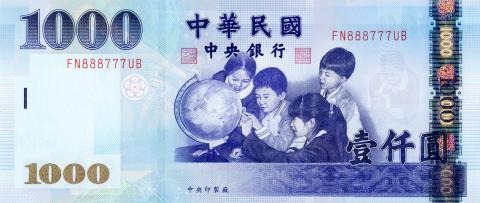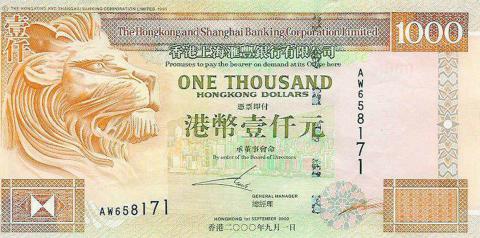A Greater Taichung man’s contention that the nation’s most common bills in circulation contain a printing error that has gone unnoticed for decades has sparked a heated debate.
Huang Pai-tsun (黃百村), a bedding merchant, said that the Chinese character for “one” (yi, 壹) on all NT$100 and NT$1,000 banknotes is incorrect.
The upper part of the character yi should be shi (士, scholar), with the top horizontal stroke longer than the bottom one, Huang said.

Photo: Lin Liang-che, Taipei Times
However, the banknotes in circulation have it wrong, he said, with the character written as tu (土, land or earth), which has a top horizontal stroke that is shorter than the bottom one.
Huang said he has double-checked with standard Chinese dictionaries and computer word processors and verified that the banknotes contain a misprint.
However, an official from the central bank’s currency issuance department denied that it was a misprint.

Photo: Lin Liang-che, Taipei Times
“There is no mistake in the Chinese character on the bills,” the official said.
Officials from the central bank’s Central Engraving and Printing Plant added that the printed characters on the currency bills were designed specifically for aesthetic purposes and to guard against counterfeiting, and, as such, differ from the regular written form.
“All printed characters on the bills were uniquely designed. If they were the same as those printed by a computer, then the bills would be easy to counterfeit,” an official said.

Photo: Lin Liang-che, Taipei Times
Yang Meng-chu (楊孟珠), a Chinese-language teacher at a senior-high school in Greater Taichung, is unconvinced, saying she thinks the central bank is wrong.
According to the Kangxi Dictionary (康熙字典), the root character for yi is shi; the central bank has therefore made a blunder by misprinting the root character as tu, Yang said.
A look at banknotes containing the character yi in China, Hong Kong and Macau show that they are printed with the root character shi.
“The Taiwanese government has always stressed that we are a country that uses the traditional Chinese system of writing. We should therefore be careful to follow the proper form,” Huang said.
“The central bank has made an error on the circulating bills. This has become an international joke. As China, Hong Kong and Macau all use the correct Han Chinese form, I want to see the central bank rectify the error at once. We should not allow this mistake to continue,” he added.
Money collector Yang Chuan-ming (楊川明) appeared to support Huang’s findings, saying he had made a careful study of all banknotes issued from the Japanese colonial era to the period right after World War II and found that all were written in the proper form.
“However, the [print] on the bills issued by the Chinese Nationalist Party (KMT) government starting from 1949 were all changed to tu,” he said.
In 1949, the KMT government had to deal with several crises, including soaring inflation and social unrest, and had to undertake a major fiscal restructuring, Yang Chuan-ming said.
“That was the time the KMT government mandated the conversion of one New Taiwan dollar for every 40,000 old Taiwan dollars. It was the start of the New Taiwan currency, with the issuance of NT$0.01, NT$0.10 and NT$100,” he said.
“From then on, the yi character on currency bills almost all had the wrong root on top. Very few bills got it right since then,” he said.

SHIPS, TRAINS AND AUTOMOBILES: The ministry has announced changes to varied transportation industries taking effect soon, with a number of effects for passengers Beginning next month, the post office is canceling signature upon delivery and written inquiry services for international registered small packets in accordance with the new policy of the Universal Postal Union, the Ministry of Transportation and Communications said yesterday. The new policy does not apply to packets that are to be delivered to China, the ministry said. Senders of international registered small packets would receive a NT$10 rebate on postage if the packets are sent from Jan. 1 to March 31, it added. The ministry said that three other policies are also scheduled to take effect next month. International cruise ship operators

HORROR STORIES: One victim recounted not realizing they had been stabbed and seeing people bleeding, while another recalled breaking down in tears after fleeing A man on Friday died after he tried to fight the knife-wielding suspect who went on a stabbing spree near two of Taipei’s busiest metro stations, Taipei Mayor Chiang Wan-an (蔣萬安) said. The 57-year-old man, identified by his family name, Yu (余), encountered the suspect at Exit M7 of Taipei Main Station and immediately tried to stop him, but was fatally wounded and later died, Chiang said, calling the incident “heartbreaking.” Yu’s family would receive at least NT$5 million (US$158,584) in compensation through the Taipei Rapid Transit Corp’s (TRTC) insurance coverage, he said after convening an emergency security response meeting yesterday morning. National

PLANNED: The suspect visited the crime scene before the killings, seeking information on how to access the roof, and had extensively researched a 2014 stabbing incident The suspect in a stabbing attack that killed three people and injured 11 in Taipei on Friday had planned the assault and set fires at other locations earlier in the day, law enforcement officials said yesterday. National Police Agency (NPA) Director-General Chang Jung-hsin (張榮興) said the suspect, a 27-year-old man named Chang Wen (張文), began the attacks at 3:40pm, first setting off smoke bombs on a road, damaging cars and motorbikes. Earlier, Chang Wen set fire to a rental room where he was staying on Gongyuan Road in Zhongzheng District (中正), Chang Jung-hsin said. The suspect later threw smoke grenades near two exits

The Forestry and Nature Conservation Agency yesterday launched a gift box to market honey “certified by a Formosan black bear” in appreciation of a beekeeper’s amicable interaction with a honey-thieving bear. Beekeeper Chih Ming-chen (池明鎮) in January inspected his bee farm in Hualien County’s Jhuosi Township (卓溪) and found that more than 20 beehives had been destroyed and many hives were eaten, with bear droppings and paw prints near the destroyed hives, the agency said. Chih returned to the farm to move the remaining beehives away that evening when he encountered a Formosan black bear only 20m away, the agency said. The bear